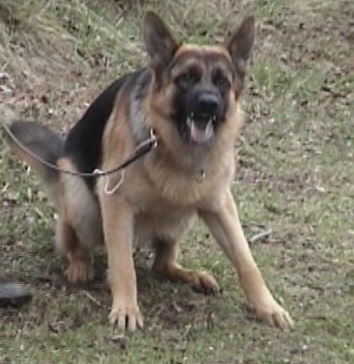Dogs communicate to and with us all the time. Whether they bark, growl, shake, or cower – they communicate not only with their voice but also with their body Unfortunately, most humans don’t listen or don’t know how to interpret their language.
Just last week a lady was telling me that her dog constantly growls at people. When I asked her how she typically responds, she shared that she is telling the dog “no.” And when I asked what the humans typically do, she told me that they will back off; after all her dog is a 60 lbs Bulldog mix. The dog has been growling at strangers for a long time and even though the behavior hasn’t gotten better, the lady never changed her training approach.
Just because a dog growls, doesn’t mean that it needs to be immediately punished; neither with voice commands such as “no” nor with physical punishment. Instead, it needs to be respected first. After all, the dog is communicating to you that something makes him uncomfortable. Punishing a dog at this moment would be the same as if your friend was telling you that she is afraid of touching your dog, and you are punishing your friend for that. Besides, if the dog has reached a higher threshold of uncomfortableness, punishing him in that moment can lead to a full-blown aggressive reaction.
If a dog growls and the human backs off, the dog will learn that growling is an effective means to get him what he wants – humans stepping away. But if humans keep moving forward even though the dog is growling, not paying attention to the dog’s communication can also lead to an aggressive reaction by the dog. So what can you do instead?
1. Stop whatever you are doing. If someone approaches your dog and your dog growls, ask them to stay where they are; don’t move forward, don’t move back; just stay neutrally. If you are close to your dog, get his attention and redirect it towards you. Wait your dog out until he relaxes and breathes normally. Then allow your friend to move away. In that way you are rewarding the relaxed behavior and the dog will learn that growling will tell the people to stop, but they won’t move away until he relaxes.
2. Identify what causes your dog to growl. Is he afraid of people? Did the other person make eye contact with him? Did they reach for something that belongs to him? Does he currently experience a lot of stress in your home?
3. Once you identified what makes your dog uncomfortable, develop a training routine that will help your dog overcome his fear, possessive or territorial behavior. Use fun and motivating training tools, keep your dog on a leash when you introduce him to strangers and make every encounter with people positive for him.
Want to learn more? Sign up for my workshop “Let’s talk dogs” on Wednesday, March 23 at 6 pm here in Marietta and I will show you step-by-step instructions on how to help your dog overcome his sense of uncomfortableness. Have another issue with your dog? Bring it and we’ll develop a solution together. The workshop is just $25 which you will donate to the rescue group of your choice. Only three more seats are available. Learn more at https://itsnotthedog.com/programs.

